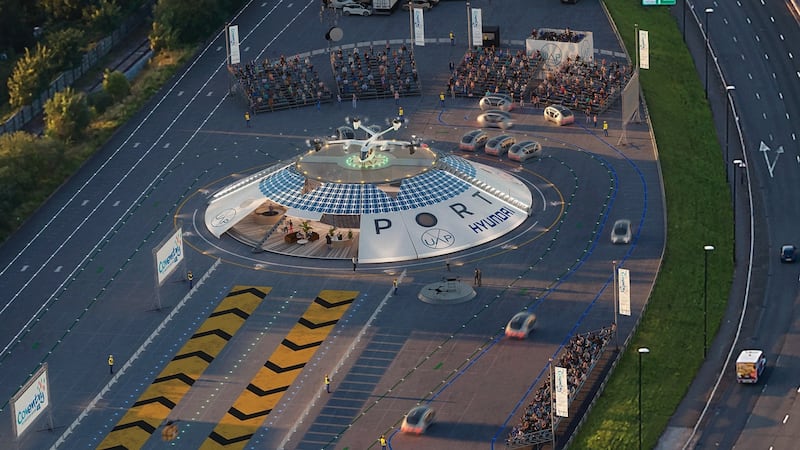The silver-and-blue aircraft sits on the hard standing. It looks as if it could have come from the golden age of aviation, that magical period in the 1920s and 1930s when faster and sleeker aeroplanes were built to go racing, rather than fighting. True, the development of these racing planes was funded by national (and nationalist) governments, keen to push the boundaries of aviation technology specifically so that better killing machines could be built, but the art-deco racers’ speed and beauty were undeniable.
The propellor begins to turn over, and your ears brace themselves for the roar and bellow of a powerful piston engine. But it never comes. The propellor buzzes and trills as its rotating tips approach the speed of sound, but there’s no engine noise. The penny drops. This isn’t the 1930s and that’s not a Schneider Trophy racing aeroplane. It’s 2021, and that’s the Rolls-Royce ACCEL prototype electric aircraft, preparing for its first flight tests.
ACCEL (which roughly stands for Accelerating the Electrification of Flight) looks spectacularly sleek and downright sexy. That’s perhaps not surprising when you consider that its role, initially, is to set speed records. To make it a little more inspiring, ACCEL is only its technical project name – the Spitfire-shaped aircraft will actually be called Spirit of Innovation.

“Aviation represents around 2-2.5 per cent of global carbon emissions. The pressure to go away from a fossil fuel source, and towards a sustainable technology, largely electric, is overwhelming,” says Ash Owen, chief engineer at Rolls-Royce (and by Rolls-Royce we mean the aircraft engine maker; the luxury car brand is actually owned by BMW, which has a licence to use the name from the aviation-focused company, the “true” Rolls-Royce if you will). Owen reckons that three technologies will be needed to push aviation to zero-carbon: better versions of existing turbofan jet engines; bio-fuels and e-fuels; and electric power.
The Spirit of Innovation has been built precisely to inspire new breakthroughs, and future engineers, in the way of electric flying. A hundred years ago, Rolls-Royce supplied faster and more powerful aero engines to aircraft maker Supermarine, as it chased the coveted Schneider Trophy for the fastest racing aeroplanes with its sleek, glamorous S5 and S6 seaplanes. Now, Rolls-Royce is chasing records again, hoping to push the Spirit of Innovation to 480km/h, or 300mph, which would be a new world record for electric aeroplanes.
Of course, there’s a limiting factor here. The Spirit of Innovation, with its racing, racy lines, holds but a single occupant, the pilot. Although it has a 500hp electric motor, and sufficient battery capacity to power it for up to 300km of flying, it will never carry you and your luggage to Magaluf. To do that, at zero carbon, we are going to need something that’s considerably more advanced, and more complex.
Electrification
In fact, maybe electrification isn’t the right solution at all for aircraft, or at least not for big ones that carry hundreds of passengers at a time. Electric power might, in the near future, be ideal for smaller, short-hop aircraft. They’re sometimes called “flying cars” but are actually more like a cross between a small helicopter and an upsized drone. Many people are piling in on this technology, seeing the potential for vast incomes as more and more intra-urban travellers start to look skywards to get away from the traffic. Korean car-making giant Hyundai is expanding into the electric aircraft market, and has announced that it will be one of the partners for an ambitious plan to install a city-centre airport in the middle of Coventry in the UK.
The Urban Air Port Air-One has received more than €1.2 million in funding from the UK government, and has plans to build the landing ground and terminal facilities for small, light electric vertical take-off (eVTOL) aircraft in Coventry city centre, adjacent to the city’s main football ground.
Of course, this is not a conventional airport, requiring thousands of metres of runway and heavy-duty infrastructure. The concept behind the Urban Air Port is centred around small electric aircraft, often erroneously referred to as “flying cars”. Actually, they’re more of a cross between a large autonomous drone and a small private helicopter. Quieter by far than a conventional helicopter, they’re designed for short, but very rapid, urban hops.
“As we advance our eVTOL aircraft programme, development of supporting infrastructure is imperative,” said Pamela Cohn, chief operating officer for the Urban Air Mobility division of Hyundai Motor Group. “Air-One is a unique project that is set to help lead the way in developing a robust, accessible and intermodal infrastructure network for future mobility. We are excited to be part of this partnership in the UK, and look forward to working together to create community impact and opportunity through safe, affordable and human-centred mobility solutions.”
Hyundai has already shown designs for its S-A1 eVTOL aircraft, which uses eight electrically driven rotors to take off and land vertically, and which has claimed performance of 290km/h and a range of 97km on one charge. Hyundai claims that the aircraft’s batteries can be replenished in just five to seven minutes. When built, it will have a capacity of four passengers.
Again, that’s not what the future of aviation will look like for longer journeys. In fact, the next generation of Ryanair and Aer Lingus aircraft will probably end up looking, feeling, and even sounding much like those that we fly on right now. The difference will be in the fuels that they burn.
Partial solution
So-called e-fuels have been propounded as a potential, partial solution to keeping existing petrol- and diesel-engined cars running in an era of zero carbon emissions. The idea is compelling: using a chemical process known as the Fischer-Tropsch process, a liquid hydrocarbon fuel, a so-called e-fuel, can be made which actually takes carbon dioxide from the atmosphere, and combines it with artificially-made hydrogen to form a hydrocarbon – the building block of a fuel. Such e-fuels have hit the headlines recently as the likes of Porsche, Siemens and Mazda have all put investment cash into projects that seek to mass-produce such fuels. Use renewable power sources (such as wind power – Siemens has set up an e-fuel pilot plant in a spectacularly windy part of Chile) to make your e-fuel and it’s carbon-neutral.
Cars, however, are likely to be – even ought to be – a minority interest in the e-fuels world. They’re far more necessary for aircraft. Why? Because of energy density.
Weight is the enemy of an aeroplane, any aeroplane. Every extra kilogram of weight carried on board, in the shape of you, me and our luggage, needs extra litres of fuel to haul that weight into the sky, keep it there, and return it safely to the ground. It’s the infernal equation of the rocket engineer: more weight needs more fuel which is itself more weight which needs more fuel...
Batteries dramatically complicate that equation, because a battery – no matter how efficient – is far less “energy dense” than an equivalent amount of liquid fuel. For comparison, a kilo of petrol contains about 47.5 megajoules of potential energy, and a kilo of fuel is roughly equivalent to a litre of fuel. Even given that jet turbofan engines are between 70 and 80 per cent efficient (in other words, they lose between 20 and 30 per cent of that energy as waste heat), that still means they’re squeezing between 33 and 38 megajoules out of each litre or kilo of fuel. A battery can’t compete. The best current lithium-ion batteries have, at best, 0.7 megajoules per kilo. The amount of batteries you’d therefore need to fly from Dublin to, say, Barcelona would vastly exceed the total weight of the aircraft and its passengers, which means you ain’t getting off the ground.
Clean future
So, e-fuels may well be the only way forward for flying. Delphine Gozillon, shipping policy officer at environmental think tank Transport & Environment, said: “E-fuels offer a clean future for the shipping and aviation sectors, but also the fuels industry. The EU must give them the investment certainty they need to flourish by requiring all ships carrying EU trade and aircraft fuelling in Europe to progressively make the switch. Promoting e-fuels can drive investment and create employment in areas such as hydrogen production, European shipbuilding and technology manufacturing, as well as energy transport infrastructure and R&D. Europe’s renewable electricity potential is sufficient to meet demand from ships and planes, recent research shows, but Europe must make the right policy decisions in 2021 to incentivise the uptake of these green fuels.”
That will create difficulties, of course. Right now, e-fuel production is measured in the few thousands of litres per year. In 2019, the global aviation sector consumed around 95 billion gallons of fuel – that’s about 351 billion litres. Gearing up to produce that much e-fuel will be a slow process, and that will mean considerably more expense in the short-to-medium term for the airline industry, a cost which will inevitably be passed on to the flying passenger.
Then there are the difficulties of pollution. E-fuels are carbon neutral, if they’re made right, but they still have other emissions, such as soot and particulates, which aren’t great things to be pumping out into high-altitude skies. It may well yet be that we need to fundamentally reorganise our methods of getting from place to place in the future, with much a much lower usage of aircraft and flying.
While the sight of Rolls-Royce’s stunning silver dream machine taking to the skies might be an inspiring one, it may well be that fewer sun holidays, and more staycations, are in our futures.




















